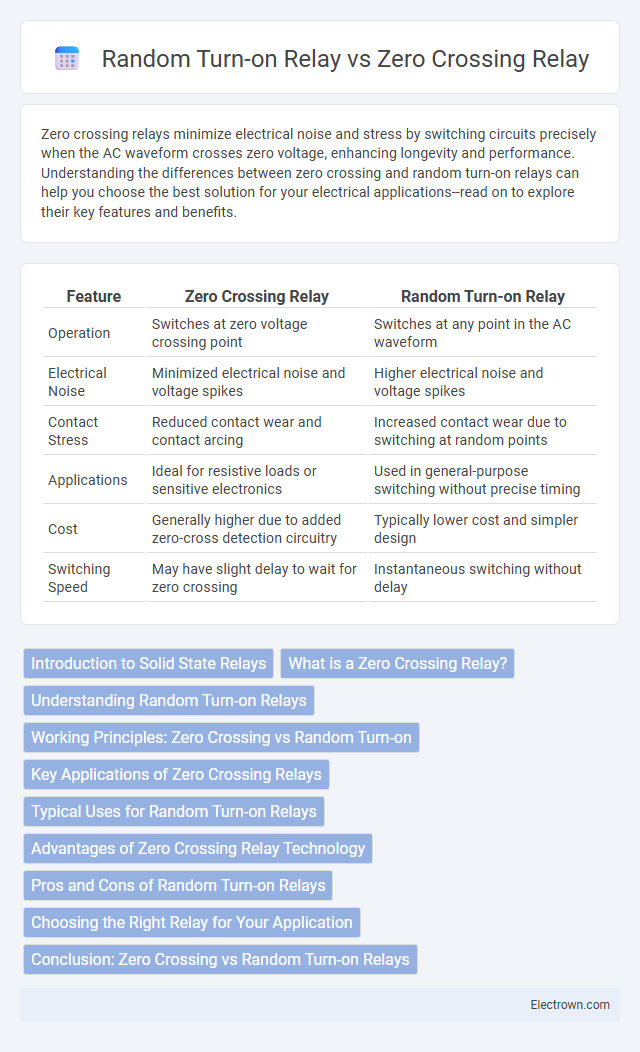Zero crossing relays minimize electrical noise and stress by switching circuits precisely when the AC waveform crosses zero voltage, enhancing longevity and performance. Understanding the differences between zero crossing and random turn-on relays can help you choose the best solution for your electrical applications--read on to explore their key features and benefits.
Table of Comparison
| Feature | Zero Crossing Relay | Random Turn-on Relay |
|---|---|---|
| Operation | Switches at zero voltage crossing point | Switches at any point in the AC waveform |
| Electrical Noise | Minimized electrical noise and voltage spikes | Higher electrical noise and voltage spikes |
| Contact Stress | Reduced contact wear and contact arcing | Increased contact wear due to switching at random points |
| Applications | Ideal for resistive loads or sensitive electronics | Used in general-purpose switching without precise timing |
| Cost | Generally higher due to added zero-cross detection circuitry | Typically lower cost and simpler design |
| Switching Speed | May have slight delay to wait for zero crossing | Instantaneous switching without delay |
Introduction to Solid State Relays
Solid State Relays (SSRs) improve electrical switching with two main types: Zero Crossing Relay and Random Turn-on Relay. Zero Crossing Relays switch on at the zero voltage point, minimizing electrical noise and reducing surge currents, making them ideal for resistive loads. Your choice depends on the application's sensitivity, with Random Turn-on Relays offering more flexible timing for inductive or capacitive loads where precise zero crossing is less critical.
What is a Zero Crossing Relay?
A Zero Crossing Relay is an electronic switching device designed to activate electrical loads precisely when the AC voltage waveform crosses the zero-voltage point, minimizing electrical noise and inrush currents. This relay enhances the lifespan of connected components by reducing electrical stress and improving energy efficiency, particularly in lighting and motor control applications. By ensuring switching occurs at zero crossing points, it effectively reduces electromagnetic interference and thermal damage.
Understanding Random Turn-on Relays
Random Turn-on relays energize their load at varying points within the AC waveform, causing potential electrical noise and reduced efficiency compared to Zero Crossing relays, which switch precisely at the zero-voltage point to minimize interference. Understanding Random Turn-on relays highlights their simpler design but higher risk of generating electromagnetic interference (EMI) and stress on connected devices. Your choice between these relay types impacts performance in applications sensitive to noise, such as lighting dimmers or motor controls.
Working Principles: Zero Crossing vs Random Turn-on
Zero Crossing Relays activate switching devices precisely when the AC waveform crosses zero voltage, minimizing electrical noise and reducing inrush current. Random Turn-on Relays trigger switching at any point within the AC cycle, which can result in electrical surges and potential interference. Understanding these distinct working principles helps you select the ideal relay type for improving circuit longevity and performance.
Key Applications of Zero Crossing Relays
Zero Crossing Relays are primarily used in applications requiring precise electrical load control, such as lighting systems, motor controls, and heating elements, where minimizing electrical noise and preventing circuit stress is crucial. These relays switch at the point where the AC voltage crosses zero, reducing transient spikes and extending the lifespan of connected devices. Your sensitive equipment benefits from improved reliability and reduced electromagnetic interference when using Zero Crossing Relays in industrial automation and power management setups.
Typical Uses for Random Turn-on Relays
Random turn-on relays are typically used in applications requiring immediate power delivery without waiting for the AC voltage to reach zero, such as in motor starting or lighting control systems that demand rapid response. They excel in scenarios where minimizing delay and ensuring instant activation overrides the need to reduce inrush current or electrical noise. Industries like HVAC, industrial automation, and stage lighting often rely on random turn-on relays for their ability to handle varied load conditions with prompt relay engagement.
Advantages of Zero Crossing Relay Technology
Zero Crossing Relay technology minimizes electrical noise and voltage spikes by switching at the point where the AC waveform crosses zero volts, reducing wear on connected devices and extending their lifespan. This precise timing enhances energy efficiency and decreases the risk of electromagnetic interference compared to Random Turn-on Relays. Improved reliability and reduced maintenance costs are key benefits that make Zero Crossing Relays ideal for sensitive electronic applications.
Pros and Cons of Random Turn-on Relays
Random turn-on relays offer faster and more flexible switching capabilities compared to zero crossing relays, making them suitable for applications requiring rapid response times. However, their main drawback is increased electrical noise and potential for electromagnetic interference, which can affect sensitive equipment and reduce overall system reliability. Your choice depends on whether speed or noise immunity is more critical for your specific application.
Choosing the Right Relay for Your Application
Choosing the right relay for your application requires understanding the specific benefits of zero crossing relays versus random turn-on relays. Zero crossing relays reduce electrical noise and minimize inrush current by switching only at the AC waveform's zero crossing point, making them ideal for sensitive electronic loads. Random turn-on relays trigger immediately upon signal, providing faster response times suited for timing-critical or high-speed switching applications where electrical noise is less of a concern.
Conclusion: Zero Crossing vs Random Turn-on Relays
Zero Crossing Relays reduce electrical noise and minimize inrush current by switching loads precisely at the AC waveform's zero voltage point, enhancing equipment lifespan and reliability. Random Turn-on Relays switch at any point in the AC cycle, potentially causing electrical noise and higher stress on components but allowing faster response times for certain applications. Your choice between these relay types should consider the balance between minimizing electrical disturbances with Zero Crossing and achieving rapid activation with Random Turn-on.
Zero Crossing Relay vs Random Turn-on Relay Infographic

 electrown.com
electrown.com